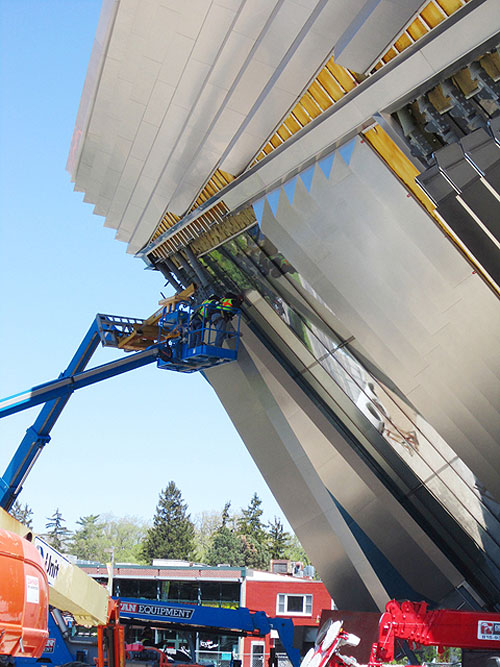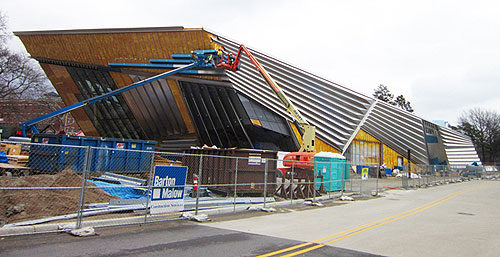Trades learn all the angles at MSU’s Broad Museum
Date Posted: May 25 2012
EAST LANSING – The new Eli and Edythe Broad Art Museum under construction on the campus of Michigan State University is itself, in many ways, a piece of art.
The museum’s architect, Zaha Hadid, calls the building’s design “attractive, flexible and future-proof.” University President Lou Anna K. Simon says the museum’s “vibrant design will engage the campus and community and inspire everyone who enters.”
Two years of construction are wrapping up on the 46,000-square-foot building at Grand River Avenue and Farm Lane. Barton Malow has been managing the $45 million project. Completion is expected at the end of the summer.
“They really pushed the envelope on the architecture of this building,” said Barton Malow Project Director Jim Ferguson. “There’s nothing off the shelf. Everything about the building has been a challenge, starting with the fact that there are so few 90-degree angles. But it’s been a great team effort to pull all this together, and I think this museum will have a great impact on the Michigan State campus, and will draw people in from around the world to see a building and art work that will be one of a kind.”
Construction of the museum was made possible by a gift from the namesake Broads, who are well-known as philanthropists in the art community. Eli Broad is an MSU alumnus. The $28 million Broad gift includes $21 million for construction, with the remaining $7 million funding art acquisitions, exhibitions and endowments and operations. The building will be the new home of the university’s art collection, currently housed on campus in the Kresge Art Center.
The museum building has a lower level, a first floor and a second floor. Floors are structural concrete. The exterior walls have pleated stainless steel and glass. The building’s highest point is 38 feet to the west, sloping to 24 feet at the east. The structural system is a hybrid of steel framing (including some at 55-degree angles) and concrete shear and bearing walls (some at 72 degrees) that creates a building that’s, well, angular. Stainless steel pleated panels will dominate the appearance of the exterior.
The LEED-rated structure has high-performance glazing, solar controls to take advantage of the sun’s energy, and energy efficient heating, ventilating and cooling system for reducing energy use and maximizing occupant comfort. One of the most sophisticated systems of this museum will be its HVAC system, which will maintain a relative humidity of 50 percent year-round in deference to sustaining the art within.
Computer-aided design was “extremely helpful” on this project, Ferguson said. “The entire project was designed in 3-D before construction started,” he said. “It really assisted us in the placement of mechanical, electrical, fire protection and plumbing. We knew going in where everything needed to go. It really assisted us; there’s very little space to run everything.”
Adjoining the building is an outdoor sculpture garden that will be an extension of the east entrance courtyard, as well as a large pedestrian plaza at the west entrance.
Ferguson said given the relatively small footprint of the building, the project peaked out at about 50-60 Hardhats. More than that and the trades workers would have been working with little elbow room. “They have been fantastic to work with, given the complicated nature of the building,” Ferguson said. “They’ve done very well in coming together to get the work done.”
Michigan State describes the London, England architect Zaha Hadid – who has designed buildings all over the world – as one who “consistently pushes the boundaries of architecture and urban design.”
Hadid was the winner of the university’s international design competition for the museum. Her company’s website describes the interior of the Broad museum: “Echoing and extending the many circulatory and visual connections that define its surrounding topography, the museum forms itself by extending and folding these connections through a series of pleats, producing a structure that changes as visitors move past and through it – creating great curiosity yet never fully revealing its content.”
Concluded Ferguson: “I think we have helped fulfill the architect’s vision.”
The Broads’ gift to fund the art museum is the largest gift by individuals in MSU’s history.
“A great university needs a great museum, since the arts stimulate learning and creativity throughout the entire campus,” said Eli Broad. “Speaking from personal experience, the arts have played a transformative role in my life, even though they were not the center of my studies at MSU. This museum – and the iconic building that will bring it to life – will also serve as an important new resource for the people of central Michigan, making great art accessible to the millions of people who live and work within the region.”

THE BROAD ART MUSEUM on the Michigan State University campus, in a photo taken earlier this spring. The LEED-certified building is shown as well-insulated and is dominated on the angular exterior by glass and pleated stainless steel.
Photos via Michigan State University

THE DEARTH OF 90-degree angles has added to the complexity of constructing the museum.
